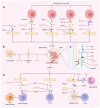Heterogeneity of primary and metastatic CAFs: From differential treatment outcomes to treatment opportunities (Review)
- PMID: 38577950
- PMCID: PMC11015919
- DOI: 10.3892/ijo.2024.5642
Heterogeneity of primary and metastatic CAFs: From differential treatment outcomes to treatment opportunities (Review)
Abstract
Compared with primary tumor sites, metastatic sites appear more resistant to treatments and respond differently to the treatment regimen. It may be due to the heterogeneity in the microenvironment between metastatic sites and primary tumors. Cancer‑associated fibroblasts (CAFs) are widely present in the tumor stroma as key components of the tumor microenvironment. Primary tumor CAFs (pCAFs) and metastatic CAFs (mCAFs) are heterogeneous in terms of source, activation mode, markers and functional phenotypes. They can shape the tumor microenvironment according to organ, showing heterogeneity between primary tumors and metastases, which may affect the sensitivity of these sites to treatment. It was hypothesized that understanding the heterogeneity between pCAFs and mCAFs can provide a glimpse into the difference in treatment outcomes, providing new ideas for improving the rate of metastasis control in various cancers.
Keywords: heterogeneity; metastatic cancer‑associated fibroblast; primary cancer-associated fibroblast; treatment opportunities; treatment outcomes; tumor microenvironment.
Conflict of interest statement
The authors declare that they have no competing interests.
Figures




Similar articles
-
Metastatic Breast Carcinoma-Associated Fibroblasts Have Enhanced Protumorigenic Properties Related to Increased IGF2 Expression.Clin Cancer Res. 2019 Dec 1;25(23):7229-7242. doi: 10.1158/1078-0432.CCR-19-1268. Epub 2019 Sep 12. Clin Cancer Res. 2019. PMID: 31515454
-
[Cancer-Associated Fibroblasts: Heterogeneity and Bimodality in Oncogenesis].Mol Biol (Mosk). 2023 Sep-Oct;57(5):739-770. Mol Biol (Mosk). 2023. PMID: 37752641 Russian.
-
Cancer-associated fibroblasts: from basic science to anticancer therapy.Exp Mol Med. 2023 Jul;55(7):1322-1332. doi: 10.1038/s12276-023-01013-0. Epub 2023 Jul 3. Exp Mol Med. 2023. PMID: 37394578 Free PMC article. Review.
-
Cancer‑associated fibroblasts: a pivotal regulator of tumor microenvironment in the context of radiotherapy.Cell Commun Signal. 2025 Mar 20;23(1):147. doi: 10.1186/s12964-025-02138-7. Cell Commun Signal. 2025. PMID: 40114180 Free PMC article. Review.
-
Architecture of Cancer-Associated Fibroblasts in Tumor Microenvironment: Mapping Their Origins, Heterogeneity, and Role in Cancer Therapy Resistance.OMICS. 2020 Jun;24(6):314-339. doi: 10.1089/omi.2020.0023. OMICS. 2020. PMID: 32496970
Cited by
-
Revisiting the role of cancer-associated fibroblasts in tumor microenvironment.Front Immunol. 2025 Apr 17;16:1582532. doi: 10.3389/fimmu.2025.1582532. eCollection 2025. Front Immunol. 2025. PMID: 40313969 Free PMC article. Review.
-
Integrative Analysis and Validation of a Cancer-associated Fibroblasts Senescence-related Signature for Risk Stratification and Therapeutic Prediction in Esophageal Squamous Cell Carcinoma.J Cancer. 2024 Sep 9;15(17):5742-5761. doi: 10.7150/jca.100430. eCollection 2024. J Cancer. 2024. PMID: 39308671 Free PMC article.
References
MeSH terms
LinkOut - more resources
Full Text Sources
Medical
